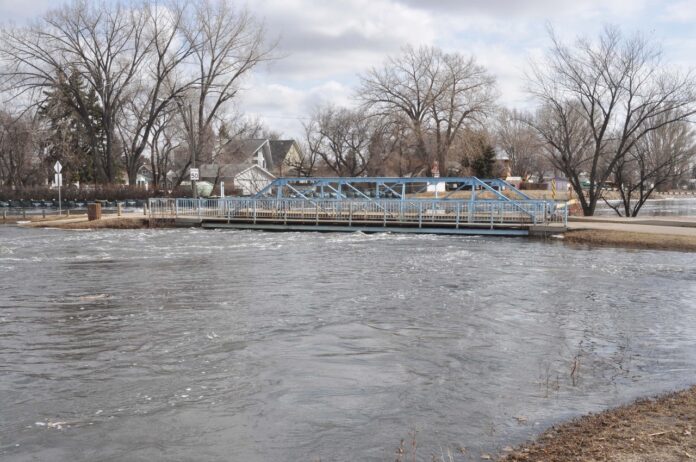
By Matthew Liebenberg
A monitoring project by the Swift Current Creek Watershed Stewards (SCCWS) has provided an update on the water quality and stream health of the creek.
The SCCWS produced a detailed report about the 2023 monitoring results to discuss and highlight the findings.
SCCWS Executive Director
said it is very important for the non-profit organization to monitor the creek’s health.
“It is part of our mandate or our mission to monitor water quality and stream health in the Swift Current Creek to be able to understand what’s happening with water quality and any changes that are coming within the watershed,” he mentioned. “There’s an old saying that you can’t manage what you don’t measure. So if we don’t know what’s going on with water quality, we can’t make the adjustments or know what kind of projects we need to do to be able to help water quality.”
However, a monitoring project is a costly and time-consuming undertaking. He noted that TC Energy provided funding for this project. The need to evaluate the potential impact of events on the creek will play a role in deciding when to carry out monitoring activities.
The 2023 monitoring project was therefore planned to evaluate the impact of several years of low rainfall in the catchment on the creek. It also looked at the potential water quality impact of the spring flooding and a major summer thunderstorm at Swift Current.
Water sampling took place at seven sites along the entire length of the creek. Sites were selected to represent the different areas of the creek.
It therefore included the headwaters, the area upstream and downstream of the Duncairn Dam, south of the city before the water treatment plant, in the city between the water and wastewater treatment plants, just north of the city, north of the town of Waldeck and near the end of the creek before its confluence with the South Saskatchewan River.
Water samples were taken four times at each site during the spring and summer. A sample was taken each month in May, June, July and August. All samples were submitted to the Roy Romanow Provincial Laboratory for testing according to various water quality parameters, including chloride, pH levels, total dissolved solids, levels of sulphate, nitrate and phosphate, as well as coliforms.
According to the report the sampling results indicate that the creek’s overall water quality is good for all uses and users. There are some exceptions, but those are not significant and can be addressed. The water quality has not changed significantly in comparison to the results from previous monitoring projects.
“I think the health is good, but there are certain things to watch for to ensure that it continues to be good,” Steinley said. “Continue efforts to make sure that the health of the creek is maintained and continue to do best management practices to maintain the health and to put some in to improve it.”
He noted that it will require ongoing actions to improve the creek’s water quality further and to address some issues.
“It’s not going to happen overnight,” he said. “It’s going to take a lot of years of implementing these practices to get to where we want to be.”
The water quality data collected during the 2023 monitoring project will therefore be useful to measure progress when compared with results from future monitoring projects.
“We’re on that road and we know that we’re not going down,” he said. “We are moving in the right direction.”
The samples taken in May did not show any noticeable impact on water quality as a result of the spring flooding. The only exception was the higher chloride levels at the site just north of Swift Current, which might have been due to more road salts and other contaminants being washed into the creek due to the flooding.
“I think the City hadn’t had a chance to clean the streets right after spreading salt and sand all winter,” he said. “Last winter was rough for roads with freezing rain and snow storms. So they didn’t have a chance to clean up before that melt hit.”
According to Steinley the biggest surprise from the water quality results was the impact of the thunderstorm with hail and heavy rain at Swift Current on July 22. Water samples for the project were taken only two days after this major rainfall event and some of the results reflected the increased stormwater run-off that occurred into the creek.
Nitrate levels at the site just north of the city increased from below 0.5 milligrams per litre (mg/L) in June to just over 2.5 mg/L in July. However, these increased levels were still well below Saskatchewan drinking water guidelines (45 mg/L) and livestock watering guidelines (100 mg/L) for nitrate concentrations.
Very high coliform and E. coli bacteria levels were also recorded at the site just north of the city in July, which can be considered to be related to the higher run-off into the creek after the intense rain storm.
Sulphate levels exceeded drinking water guidelines at the site just north of Waldeck in June and August and at the site at the north end of the creek in June. This was a result of localized conditions, for example the flow at the creek at the site north of Waldeck slows down suddenly after several course directions.
The results from the 2023 monitoring project did not reflect any clear impact of lower rainfall on water quality in the creek.
“I don’t think we’ve seen anything different than what we have in previous years in terms of the impact of the drought and the long hot summer,” he said. “It would be nice if we could do some sampling in a wet year so we can compare what happened in a wet year to a dry year, because we haven’t really had the opportunity in the last number of years to be able to see what happens in a wet year.”
The SCCWS will use the 2023 monitoring project report and results as part of ongoing efforts to inform and educate water users about the importance of water quality and stream health.
The detailed water quality monitoring report is available under the projects tab on the SCCWS website at www.sccws.com





